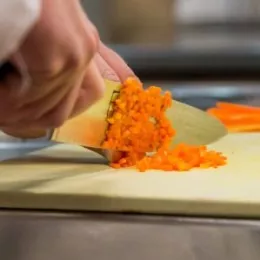You see things outside the culinary box. Chef Herve Malivert, Director of Food Technology at the International Culinary Center, took students and alums through a tour of simple modern gastronomy even the home cook can conquer. That is, if you can get your hands on some liquid nitrogen.
1. Faux Noodles
As I watched Chef Herve transform oil and water into a “noodle,” all I could do was scratch my head. How could he even get oil and water to emulsify when the two are intrinsically polar opposites? This was the first magic trick Chef Herve pulled out of his hat during his food technology demonstration, and it involved the help of a chemical called methyl cellulose. Adding less than 1 percent of methyl cellulose will allow the oil and water to emulsify into a mayo-like consistency. He used this concoction to add another dimension to consommé, a clear soup. Using a squeeze bottle, he piped tiny strips of the emulsion into the soup, which solidified when it came in contact with the hot liquid. The noodle resembled the texture of soft Udon.

2. Coca Cola Caviar?
Transforming any liquid into a tiny, pearl of jelly is an interesting way to add a pop–literally!–of flavor to a dish. Chef Herve took the popular soda, Coca Cola, added 1 percent agar, a gelling agent, to it and dripped the soda into a water bath containing 5 to 8 percent lactate, which solidified the Coke into little balls of caviar. Only bathe the caviar in this solution for a minute–the longer it’s submerge, the denser the gel will become.

3. Instant Ice Cream
Want to really impress your friends? Invest in some liquid nitrogen, whip up a creme anglaise, and shower your custard with liquid nitrogen to make a quick batch of ice cream. Pour the creme anglaise–a mixture of eggs, sugar, and cream–into a stand mixer. While on a low speed, add the liquid nitrogen. You’ll use about a 50:50 ratio of creme anglaise to liquid nitrogen, but you can eyeball the process. Once the ice cream comes to the right consistency, stop adding nitrogen. Top with caviar!
Herve Malivert was formerly on staff at the International Culinary Center (ICC), founded as The French Culinary Institute (FCI). In 2020, ICE and ICC came together on one strong and dynamic national platform at ICE's campuses in New York City and Los Angeles. The school and this chef’s culinary education legacy live on at ICE, where you can explore your own future in food.



